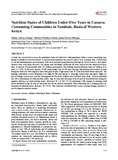| dc.contributor.author | Nungo, Rhoda Azikoyo | |
| dc.contributor.author | Okoth, Michael Wandayi | |
| dc.contributor.author | Mbugua, Samuel Kuria | |
| dc.date.accessioned | 2013-06-26T07:56:54Z | |
| dc.date.available | 2013-06-26T07:56:54Z | |
| dc.date.issued | 2012-06 | |
| dc.identifier.citation | R. Nungo, M. Okoth and S. Mbugua, "Nutrition Status of Children Under-Five Years in Cassava Consuming Communities in Nambale, Busia of Western Kenya," Food and Nutrition Sciences, Vol. 3 No. 6, 2012, pp. 796-801. doi: 10.4236/fns.2012.36107. | en |
| dc.identifier.uri | http://www.scirp.org/journal/PaperInformation.aspx?paperID=19936& | |
| dc.identifier.uri | http://erepository.uonbi.ac.ke:8080/xmlui/handle/123456789/40245 | |
| dc.description.abstract | A study was carried out to assess the nutritional status of under-five child population within cassava consuming community in Nambale of western Kenya. A structured questionnaire was used to collect socio -economic data, 24-hour food re-call and anthropometric measurements. Data were analyzed using Statistical Package for Social Sciences. Descriptive statistics were used while Pearson’s Chi Square and correlation coefficient (R) were used to test for statistical associations. A total of 320 households with 232 children participated. The findings showed nutrition status of children to be poor (<-2 SD), 26.6% were stunted, 13.9% underweight, and 10.1% were wasting. Malnutrition had reached its peak during the third year affecting boys more than girls despite a high mean score (9.2) for household dietary diversity. The findings established cassava utilization to be high (94.3%) and mainly as “porridge, boiled roots and ugali”. Eight staples including cassava were used for weaning and 66.4% of the children were fed three times daily. Cassava utilization was not a determinant of child nutrition status. Age of child and education level of head of household had strong but negative influence on child nutrition status, (Pearson’s R = -0.207: -0.174) indicating >50% changes in stunting could not be attributed to age of child or education level of the head of household. Farm ownership was a strong positive determinant of nutrition status, Pearson’s R = 0.233. This study has established that cassava cushions hunger and there is need to improve nutrient content. | en |
| dc.language.iso | en | en |
| dc.publisher | University of Nairobi | en |
| dc.subject | Cassava; Children; Nutritional Status; Utilization | en |
| dc.title | Nutrition Status of Children Under-Five Years in Cassava Consuming Communities in Nambale, Busia of Western Kenya | en |
| dc.type | Working Paper | en |
| local.publisher | Faculty of Agriculture | en |

